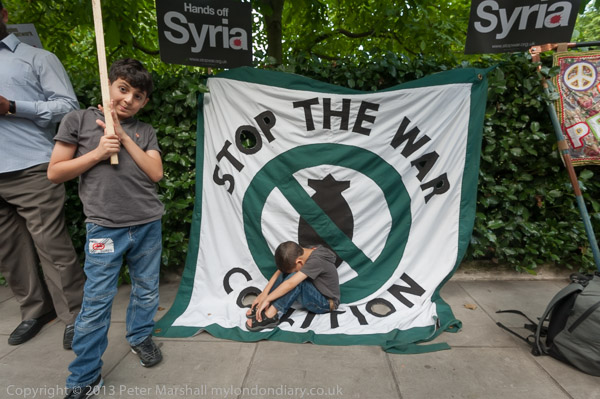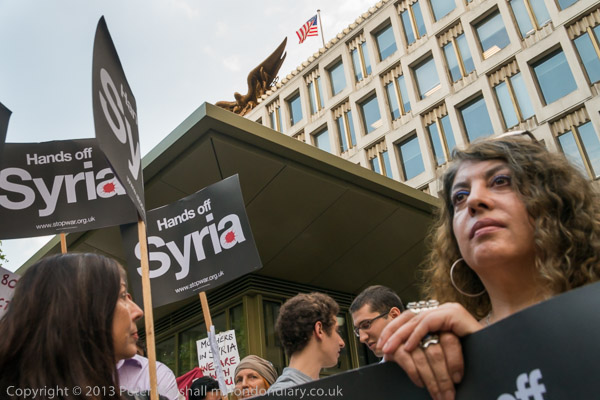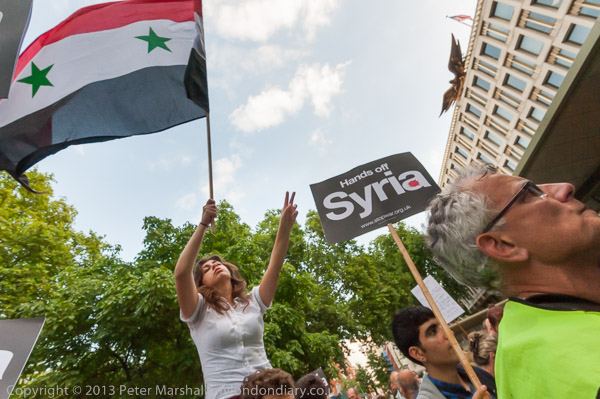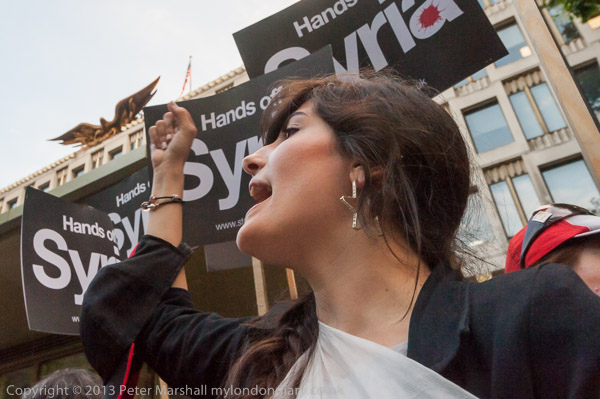
Two boys, I think brothers, at the protest.
I arrived late for Hands off Syria, a protest outside the US Embassy in Grosvenor Square, and more or less as I walked in the protest seemed likely to be disintegrating as a strong faction supporting the Syrian regime and President Assad began to erupt against a speaker who had begun to talk about the discrimination against the Kurds in Syria.
A number of protests in recent years by Stop the War have brought together groups with very different viewpoints. When they protested against our air attacks on Libya, there were both pro- and anti-Gadaffi groups who came, although then those against the dictator were mainly also in favour of the air attacks.
Here I think everyone was against military intervention by the West, but little else united the protesters. Taking place after the House of Commons vote had turned down any British intervention, the protesters were here to call on Obama not to attack.

I always like to show the US Eagle and flag when I’m at the embassy – and this is nicely not too obvious
Although I can’t feel much sympathy for those pro-Assad protesters – he’s a brutal dictator who should have been consigned to history long ago (and I suspect only kept in power by cynical Western support) and responsible for the massacre of many thousands of the Syrian people – they do provide some good images. And of course what they were saying about there being no discrimination against the Kurds in Syria, and the Syrian people being as one was total nonsense, as anyone who has done the slightest research would know. They must all read the Syrian equivalent of the Daily Mail and believe all its lies.
It’s hard to see any sensible policy towards Syria. Like most of the Middle East it isn’t really a country but an artificial construct that suited Western policy towards the area some time in the last century when the lines were drawn on maps. We should have found ways to support democratic and progressive movements across the area over the years, but instead chose to back some very reactionary monsters mainly on behalf of our oil companies. Which leaves us in the current mess.

A rather odd angle was needed to include everything I wanted
But I was there to take pictures, not make political speeches, and I got on with it, stifling my disbelief at some of the speeches, particularly those that claimed that the recent vote was some kind of victory for the anti-war movement rather than arising from sheer stupidity by David Cameron in refusing to compromise with Labour. If he’d done so the vote would have gone the other way – and what claims about success could have been made then?
The official Stop the War protest ended fairly soon after, and they started packing up, leaving most of the stage to the Syrians, who began a much more lively event.

There is something very odd about that image of Assad, somehow too smooth, too polished, too heavily retouched, something wrong with his eyes, and I do find the whole personality cult disturbing.

By this time the wind had dropped and the flag wasn’t playing the game, which was just a little disappointing. This woman in particular was good to photograph, very demonstrative. There is often a problem with photographing a protest that people just stand there, doing nothing, saying nothing, but there was plenty of action at this one – as you can see at Hands off Syria.